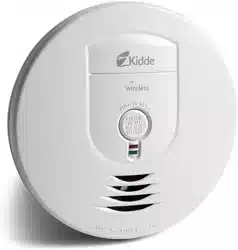Loading ...
Loading ...
Loading ...

chamber) by using compressed air or a vacuum cleaner hose around the perime-
ter of the alarm. The outside of the alarm can be wiped with a damp cloth.
After cleaning, reinstall your alarm, verify the green LED blinks every 10 seconds
and test your alarm by using the test button. If cleaning does not restore the
alarm to normal operation the alarm should be replaced.
7. LIMITATIONS OF SMOKE ALARMS
WARNING: PLEASE READ CAREFULLY AND THOROUGHLY
• NFPA 72 states: Life safety from fire in residential occupancies is based prima-
rily on early notification to occupants of the need to escape, followed by the
appropriate egress actions by those occupants. Fire warning systems for
dwelling units are capable of protecting about half of the occupants in
potentially fatal fires. Victims are often intimate with the fire, too old or
young, or physically or mentally impaired such that they cannot escape even
when warned early enough so that escape should be possible. For these peo-
ple, other strategies such as protection-in-place or assisted escape or rescue
are necessary.
• Smoke alarms are devices that can provide early warning of possible fires at
a reasonable cost; however, alarms have sensing limitations. Ionization
sensing alarms may detect invisible fire particles (associated with fast
flaming fires) sooner than photoelectric alarms. Photoelectric sensing
alarms may detect visible fire particles (associated with slow smolder-
ing fires) sooner than ionization alarms. Home fires develop in differ-
ent ways and are often unpredictable. For maximum protection,
Kidde recommends that both Ionization and Photoelectric alarms be
installed.
• A battery-powered alarm must have a battery of the specified type, in good
condition and installed properly.
• AC powered alarms (without battery backup) will not operate if the AC
power has been cut off, such as by an electrical fire or an open fuse.
• Smoke alarms must be tested regularly to make sure the batteries and the
alarm circuits are in good operating condition.
• Smoke alarms cannot provide an alarm if smoke does not reach the alarm.
Therefore, smoke alarms may not sense fires starting in chimneys, walls, on
roofs, on the other side of a closed door or on a different floor.
• If the alarm is located outside the bedroom or on a different floor, it may not
wake up a sound sleeper.
Loading ...
Loading ...
Loading ...
